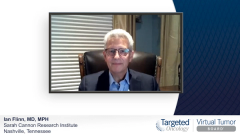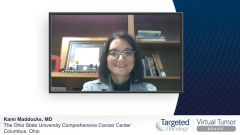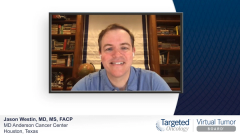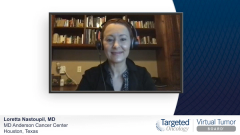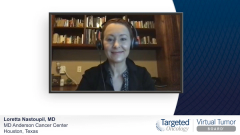
Case 1: Therapy for Relapsed DLBCL in Transplant-Eligible Patients
Kami Maddocks, MD: We know that this patient, as described, is facing poor outcomes. What are the treatment options?
Loretta Nastoupil, MD: CAR [chimeric antigen receptor] T[-cell] therapy is an option for patients who failed at least 2 lines of therapy. I think [it] has been one of the most transformative options of the patients with chemorefractory disease. I recognize that it is underutilized and there may be many reasons for this, including patient identification. You must refer them to a designated center to administer this treatment. About 40% of patients will have good outcomes, and 60% unfortunately will not. And there are lots of factors playing into why this is underutilized. But for chemorefractory patients in third line it is my preferred choice, and something I would consider for this patient.
Ian Flinn, MD, MPH: I agree. The biggest decision you’re making at this point is: Do you think that you can cure this patient? Or is this a patient for whom cure is still a goal? CAR T-cells are the only therapy that offers … at least that hope. All the other options that we’re talking about … other salvage regimens, other new therapies that have been proven, are largely trying to palliate the patient and improve their survival and their quality of life if they aren’t cured. In my mind, the only potentially curative option for this patient is a CAR T-cell. And this patient seems to be fit enough to undergo that type of therapy.
Jason Westin, MD, MS, FACP: I agree with the other panelists. CAR T-cell therapy is underutilized but it is potentially curative. And the reason it’s underutilized is it’s challenging to administer and somebody has to usually travel to a faraway academic center. And, how do you refer, and how does the logistics work? … Treating physicians shouldn’t try to guess which patients are eligible for CAR T-cells—that’s the job of the CAR T-cell center. A lot of times it’s unclear if you’re not transplant eligible, are you CAR T-cell eligible? … But their referral to a center early on, if somebody’s had additional therapy their chances for CAR T-cells may diminish. Their chances for success with CAR T-cells may diminish, the more lines of chemotherapy that they got, especially if they were to get bendamustine or other T-cell toxic therapies. Referring early for an evaluation for CAR T-cells is important for these patients.
Kami Maddocks, MD: Is this a patient that anybody would ever still offer an autologous stem cell transplant if maybe CAR T weren’t available or it seemed hard? I think probably prior to the availability CAR T you may have said this is a patient you might try a second salvage in, and if they get a response to a second salvage, go to auto-transplant? But I’m not sure would anybody consider that with the therapies available today.
Loretta Nastoupil, MD: I wouldn’t think there are practices that you have to use what’s available to you. Part of our job, particularly in this session, is to educate and identify. There are other options. CAR T is my preferred option. … If you have a curative option, pursue that first. But there are several options that I think are probably safer and more effective than attempting a second salvage attempt.
Jason Westin, MD, MS, FACP: In the CORAL study [NCT00137995] that we mentioned earlier, there was a crossover where people would go on to get the other salvage therapies. If they didn’t respond to R-ICE [rituximab, ifosfamide, carboplatin, and etoposide phosphate]or R-DHAP [rituximab, dexamethasone, cytarabine, cisplatin], they’d crossover. And the response rates aren’t 0, but they’re low and it’s toxic and because we have other options it doesn’t make a lot of sense in the modern era to continue to beat up somebody and potentially cause renal issues, neuropathies or other cytopenias when you’ve got these other smarter options. I agree, I would not likely pursue that if I had other options available.
Kami Maddocks, MD: Dr Westin, you alluded to this, but when people are referring for CAR T therapy, when is the ideal time to refer the patient in, or question if this might be a potential therapy?
Jason Westin, MD, MS, FACP: The ideal time is the first time you think that this might be an ideal therapy, the sooner the better. CAR T-cells are logistically challenging. They take time to get a financial approval. They take time to get the apheresis arranged. They take time to make the cells and then have them sent back. … Dr Nastoupil just recently published a beautiful paper in the Journal of Clinical Oncology looking at real-world evidence for CAR T-cells. Patients who need to get so-called bridging therapy, or chemotherapy, radiation-targeted therapy to hold them over don’t do as well, and that’s probably a surrogate for advanced disease. The sooner, the better.
If somebody has a relapse or doesn’t respond to a therapy and is now eligible for CAR T, the time to refer is now, not trying to think of other options or trying to evaluate a third-line therapy. If they’re a CAR T-cell candidate, my bias is to refer. And if it doesn’t work, if they don’t go or the patient doesn’t want to travel, at least you’ve given them [the] option. But if you wait, sometimes you can miss your window.
Ian Flinn, MD, MPH: It’s hard to overestimate some of the logistical issues that surround giving CAR T-cell therapy. And I agree, getting people in as early as possible is key. Otherwise, just sometimes the financial clearance, all the issues that go through getting a patient a CAR T-cell therapy, that timeline is long. And even if you haven’t already done the scans, you’re sensing that something is not going well, a lot of our referring doctors will refer at that time, just in the notion that they might need us in the future. And I really think that’s … an appropriate approach.
Kami Maddocks, MD: It sounds like if you have a patient with relapsed large-cell lymphoma, it’s a good time to at least send a referral to a CAR T center to help decide whether they’re transplant eligible, whether they’re CAR T eligible, that might mean something different. Even if they’ll go for transplant, maybe they’ll end up with CAR T. Right away when you have that relapse might be the ideal time to be sending them and thinking about it.
Dr Westin also referred to bridging therapy. In the bridging, I know there is not great data here, but is there a time when you think about giving bridging therapy? How do you find this? Is there a therapy that’s more ideal in the bridging therapy setting?
Jason Westin, MD, MS, FACP: I don’t think that there’s a standard, nor do I think there should be a standard here because every patient is different. Sometimes radiation may be an option if it’s a localized disease that’s causing significant pain or other comorbidity. The short answer is I don’t like giving bridging therapy unless I must. And it’s those patients … where you have to choose, is it going to be chemotherapy, radiation, some other targeted therapy? But the less bridging you can give, the better for the patient, they’re sicker. You’ve got greater risk for infections that could potentially derail the ability to administer CAR T.
Back to the idea of timing. The sooner you start the process, the less likely you are to need bridging. Some patients can’t wait, and it doesn’t seem like it matters what bridging therapy you give. Those patients who need it don’t do as well. I don’t think it’s the bridging therapy itself that does that, although it could contribute. It’s the underlying disease biology, but everybody’s got their own sort of preferences for what types of bridges they use. I like using systemic chemotherapy, if it’s not localized disease, but there’s not a right answer to what bridge to give.
Transcript edited for clarity.



